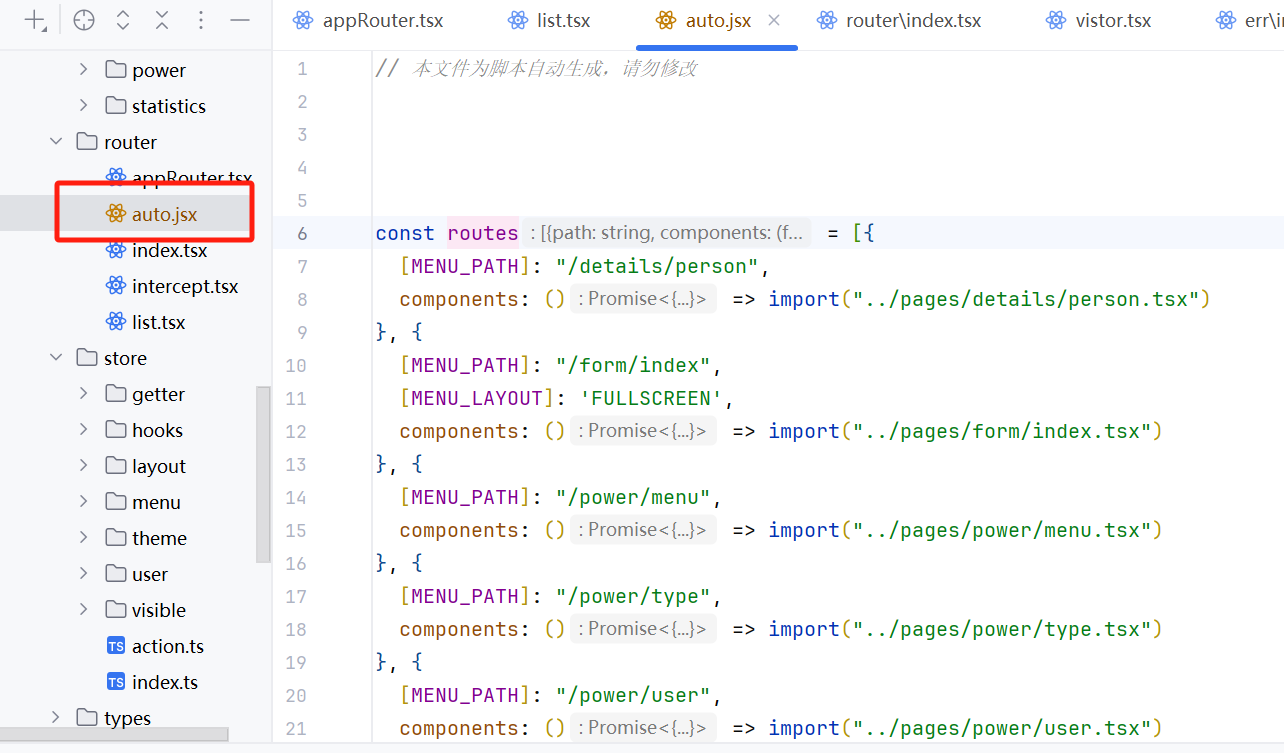前言:
react项目实际使用中有很多提升性能与功能的插件,今天来说一说vite里面提供的vite-plugin-react-router-generator,他主要提供了自动生成路由的功能,配合我们的@loadable/component可以实现路由的懒加载与统一管理。
1、实现效果
会自动生成一个jsx文件,将本地文件夹下的文件对应生成路径


2、使用过程
安装
npm/pnpm/cnpm都一样,yarn的话用 yarn add 来安装
npm i vite-plugin-react-router-generator
yarn add vite-plugin-react-router-generator路由懒加载的安装命令
npm i @loadable/componentvite.config.ts中配置
import { defineConfig } from 'vite'
import react from '@vitejs/plugin-react'
import { resolve } from "path"
// 引入
import ReactRouterGenerator from "vite-plugin-react-router-generator"
export default defineConfig({
plugins: [
react(),
reactRouterGenerator({
// outputFile必须要有
// pagesDir: 'src/pages', // 指定页面目录
// outputFile: 'src/routes.ts', // 输出路由配置文件
outputFile: resolve(".", "./src/router/auto.jsx"),//resolve(".", ...)是为了确保路径解析的准确性,避免不同操作系统的路径分隔符问题。
format: 'react-router-v6', // 生成的路由格式,非必须
isLazy: true, // 是否懒加载,非必须,如果为 true,生成的组件会通过 React.lazy(() => import('路径')) 动态导入,实现代码分割(按需加载
comKey: "components" //非必须,组件导入别名 @/components/默认值: 无(通常默认为 'pages' 或 'views',具体看插件实现)
}),
],
});
如果这里的设置isLazy设置true的话,配置路由就是:
// 生成的路由配置示例
const routes = [{
path: '/home',
element: React.lazy(() => import('@/pages/home')), // 懒加载
}];反之,不设置或者设置false,配置路由就是:则直接静态导入组件
import Home from '@/pages/home';
const routes = [{ path: '/home', element: <Home /> }];生成的auto.jsx案例:
// 本文件为脚本自动生成,请勿修改
const routes = [{
[MENU_PATH]: "/details/person",
components: () => import("../pages/details/person.tsx")
}, {
[MENU_PATH]: "/form/index",
[MENU_LAYOUT]: 'FULLSCREEN',
components: () => import("../pages/form/index.tsx")
}, {
[MENU_PATH]: "/power/menu",
components: () => import("../pages/power/menu.tsx")
}, {
[MENU_PATH]: "/power/type",
components: () => import("../pages/power/type.tsx")
}, {
[MENU_PATH]: "/power/user",
components: () => import("../pages/power/user.tsx")
}, {
[MENU_PATH]: "/list/card",
components: () => import("../pages/list/card.tsx")
}, {
[MENU_PATH]: "/list/search",
components: () => import("../pages/list/search.tsx")
}, {
[MENU_PATH]: "/icons",
components: () => import("../pages/icons/index.tsx")
}, {
[MENU_PATH]: "/statistics/feedback",
components: () => import("../pages/statistics/feedback.tsx")
}, {
[MENU_PATH]: "/statistics/visitor",
components: () => import("../pages/statistics/vistor.tsx")
}];
export default routesauto.jsx的具体使用:router/index.jsx中使用
路由懒加载方法
loadable(item.components, { fallback: <Spin style={fellbackStyle} tip="页面加载中...." /> })
import auto from "./auto.jsx";
import { Navigate } from "react-router-dom";
import Error from "@/pages/err"
type LoadingComponent = () => Promise<React.ReactNode>
//定义类型
export interface RouterInfo {
components: LoadingComponent | React.ReactNode
[MENU_PATH]: string
[MENU_KEY]?: any
[MENU_TITLE]?: string | any
[MENU_KEEPALIVE]?: string | any
[name: string]: any
}
// 写的固定的路由
const defaultArr: RouterInfo[] = [
{
[MENU_PATH]: "/",
[MENU_KEY]: "index",
components: <Navigate to="/details/person" replace />,
},
{
[MENU_PATH]: "/404",
components: <Error />,
},
.......
]
const autoList: RouterInfo[] = []
// 循环遍历我们生成的jsx里面的路由,然后生成最新路由文件,和我们写的固定的相互合并
auto.forEach(item => {
const { components, ...anyProps } = item
const Com = loadable(item.components, { fallback: <Spin style={fellbackStyle} tip="页面加载中...." /> })
const info = { ...anyProps, components: <Com /> }
autoList.push(info)
})
const list: RouterInfo[] = [...autoList, ...defaultArr]
export default list;